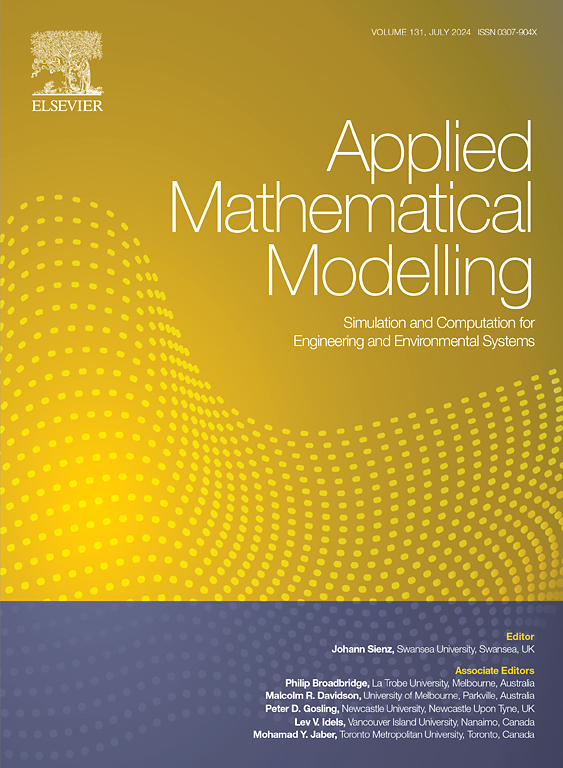混凝过程中聚合体形态和粒度分布的随机颗粒模型
IF 4.4
2区 工程技术
Q1 ENGINEERING, MULTIDISCIPLINARY
引用次数: 0
摘要
本研究基于弹道团聚-团聚(BCCA)机制,提出了一种新的简单高效的粒子模型。将所提出的随机方位-切点(ROTP-BCCA)模型应用于蒙特卡罗方法,以研究自由分子体系下的团聚凝结过程。首先使用所提出的 ROTP-BCCA 模型预测由单分散原生粒子组成的聚集体的分形特征,并通过之前报道的结果进行验证,同时与 Lindberg 等人的方法(L-BCCA 模型)进行比较。然后还研究了原生颗粒多分散性对聚集体的分形特征、前三阶矩和粒度分布(PSD)的影响。结果表明,本 ROTP-BCCA 模型得到的单分散和多分散原生粒子的分形特征、前三阶矩和聚集体的粒度分布与 L-BCCA 模型的结果非常吻合。此外,本 ROTP-BCCA 模型的计算效率远高于 L-BCCA 模型。本文章由计算机程序翻译,如有差异,请以英文原文为准。
A stochastic particle model for aggregate morphology and particle size distributions under coagulation process
A new simple and efficient particle model is proposed in the present study based on the ballistic cluster–cluster agglomeration (BCCA) mechanism. The proposed Random Orientation-Tangent Point (ROTP-BCCA) model is implemented into the Monte Carlo method to investigate the aggregate coagulation process under the free molecular regime. The proposed ROTP-BCCA model is firstly used to predict the fractal characteristics of aggregates composed of monodispersed primary particles and validated by the previously reported results and is compared with the method of Lindberg et al. (L-BCCA model). Then the effects of primary particle polydispersity on the fractal characteristics, the first three order moments and the particle size distributions (PSD) of the aggregates are also investigated. The results show that the obtained fractal characteristics, the first three order moments and the particle size distributions of the aggregates for monodispersed and polydispersed primary particles from the present ROTP-BCCA model agree well with the results of L-BCCA model. Furthermore, the computational efficiency of the present proposed ROTP-BCCA model is proved to be much higher than the L-BCCA model.
求助全文
通过发布文献求助,成功后即可免费获取论文全文。
去求助
来源期刊

Applied Mathematical Modelling
数学-工程:综合
CiteScore
9.80
自引率
8.00%
发文量
508
审稿时长
43 days
期刊介绍:
Applied Mathematical Modelling focuses on research related to the mathematical modelling of engineering and environmental processes, manufacturing, and industrial systems. A significant emerging area of research activity involves multiphysics processes, and contributions in this area are particularly encouraged.
This influential publication covers a wide spectrum of subjects including heat transfer, fluid mechanics, CFD, and transport phenomena; solid mechanics and mechanics of metals; electromagnets and MHD; reliability modelling and system optimization; finite volume, finite element, and boundary element procedures; modelling of inventory, industrial, manufacturing and logistics systems for viable decision making; civil engineering systems and structures; mineral and energy resources; relevant software engineering issues associated with CAD and CAE; and materials and metallurgical engineering.
Applied Mathematical Modelling is primarily interested in papers developing increased insights into real-world problems through novel mathematical modelling, novel applications or a combination of these. Papers employing existing numerical techniques must demonstrate sufficient novelty in the solution of practical problems. Papers on fuzzy logic in decision-making or purely financial mathematics are normally not considered. Research on fractional differential equations, bifurcation, and numerical methods needs to include practical examples. Population dynamics must solve realistic scenarios. Papers in the area of logistics and business modelling should demonstrate meaningful managerial insight. Submissions with no real-world application will not be considered.
 求助内容:
求助内容: 应助结果提醒方式:
应助结果提醒方式:


